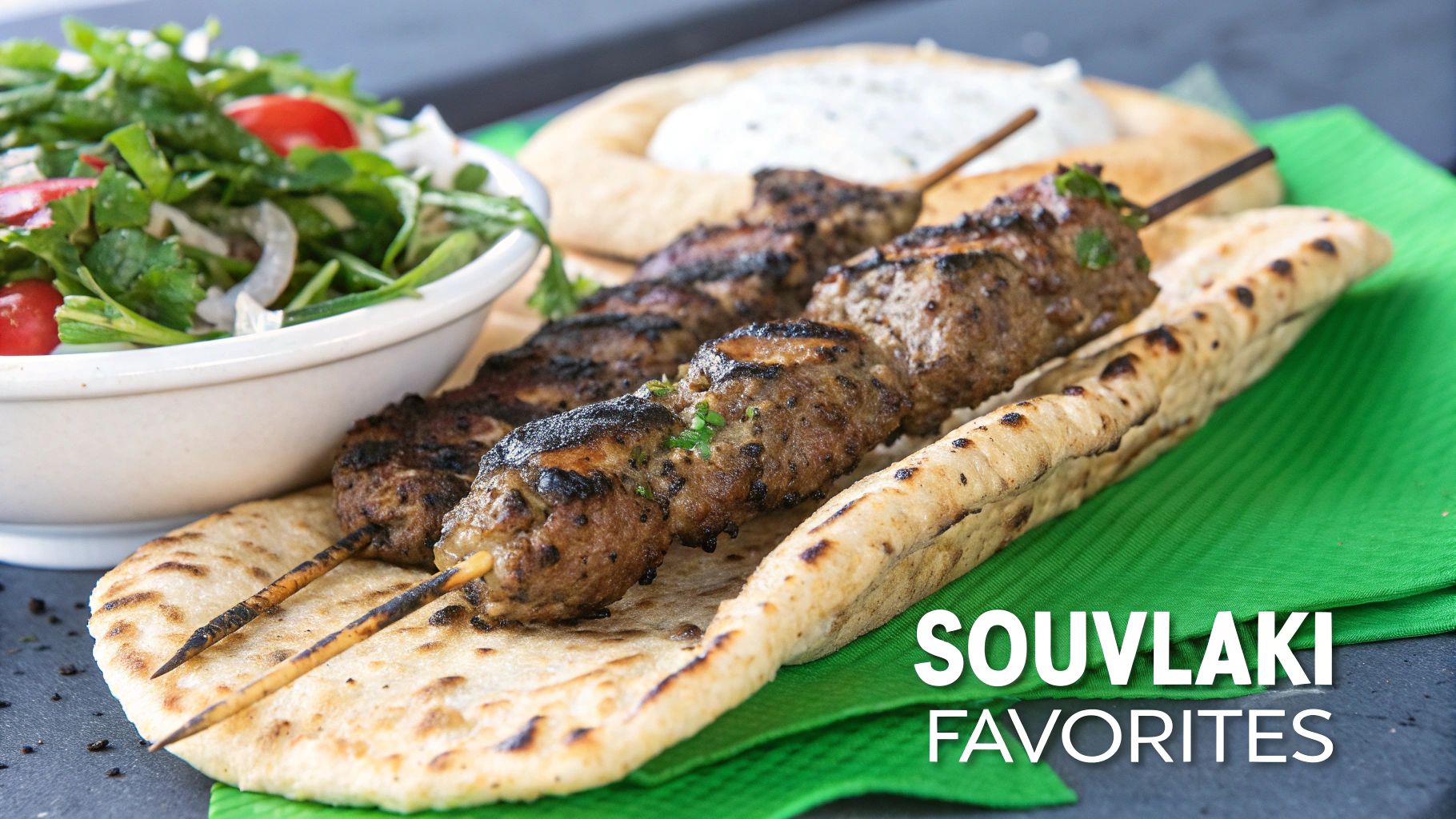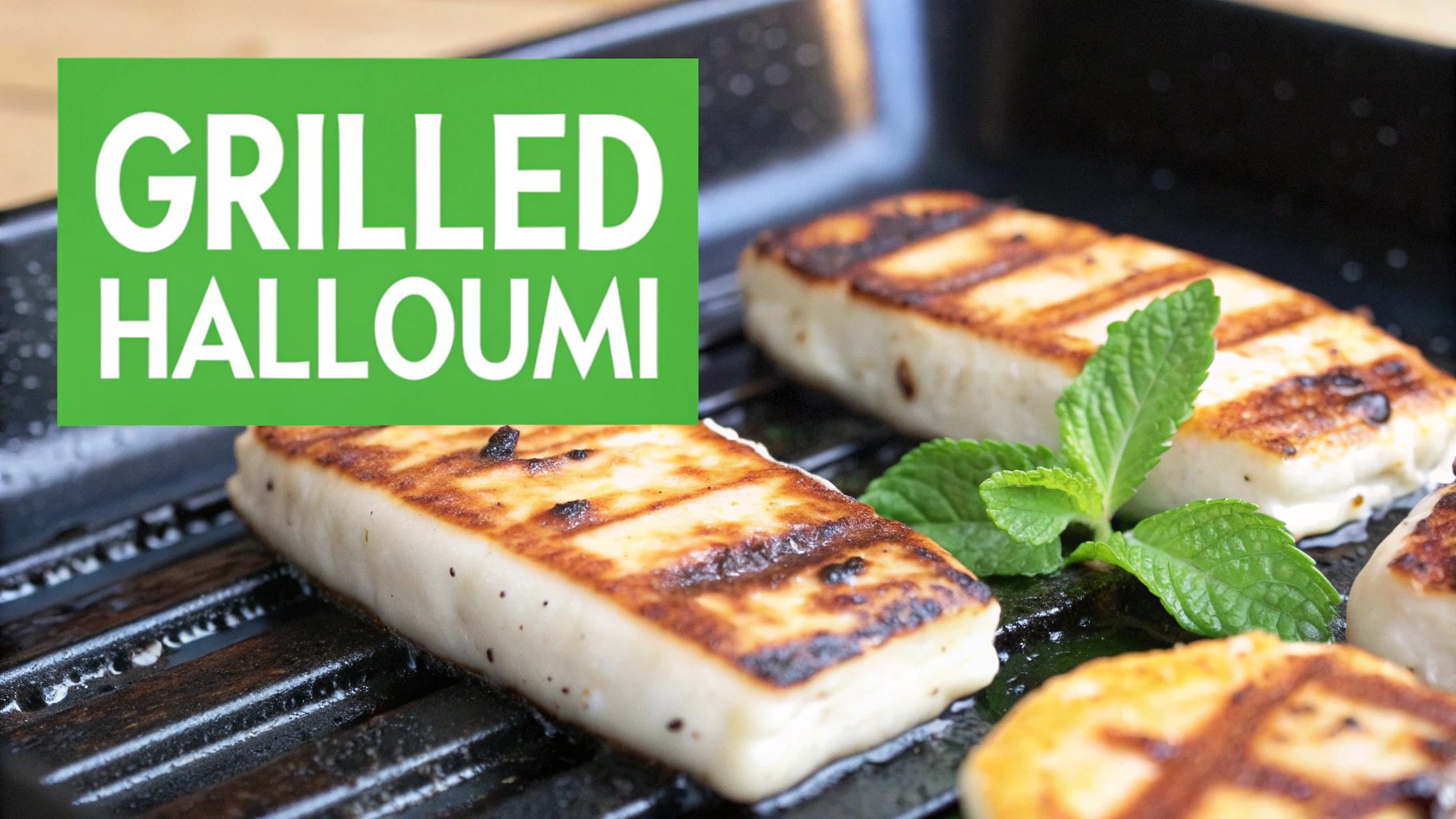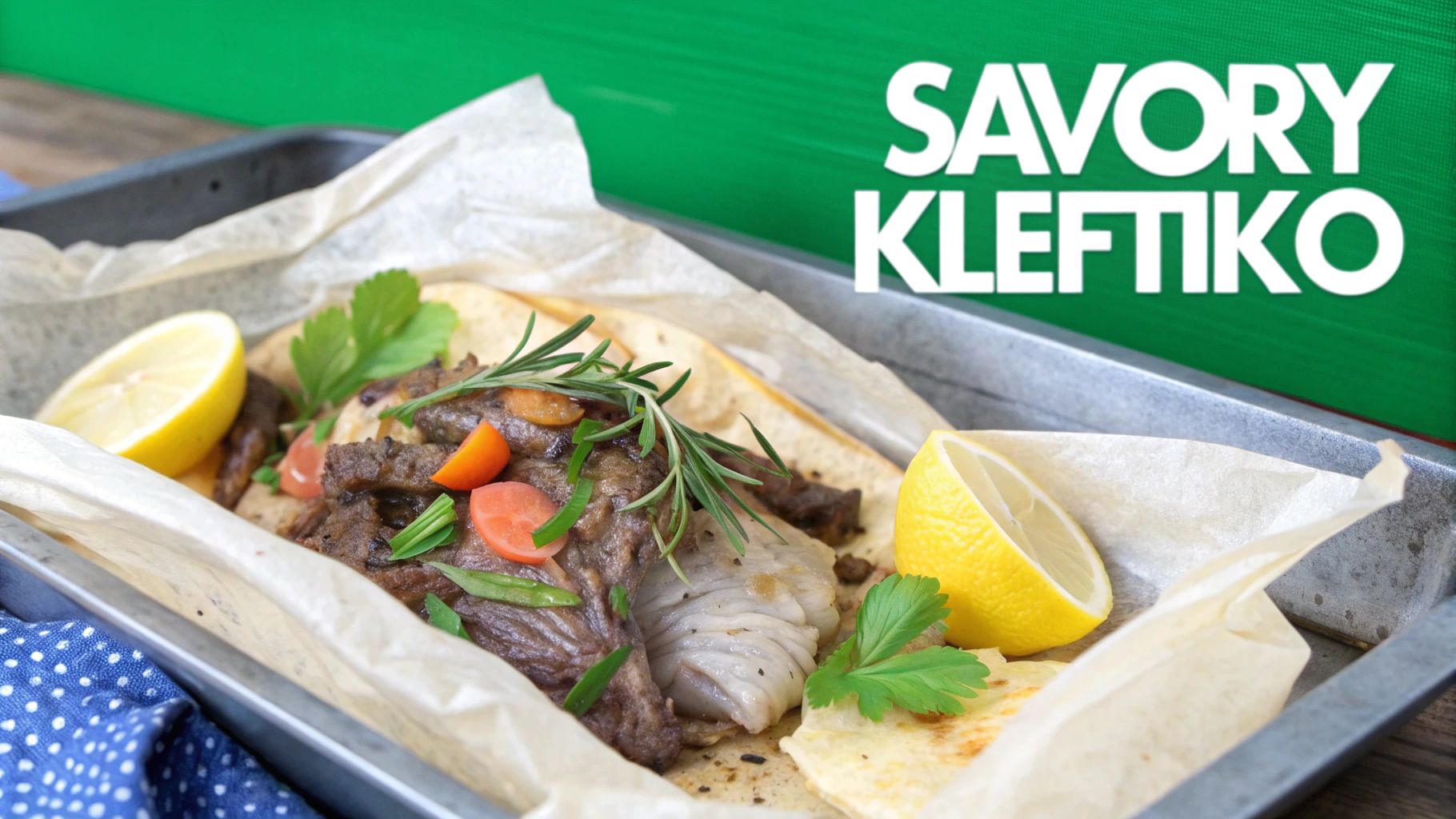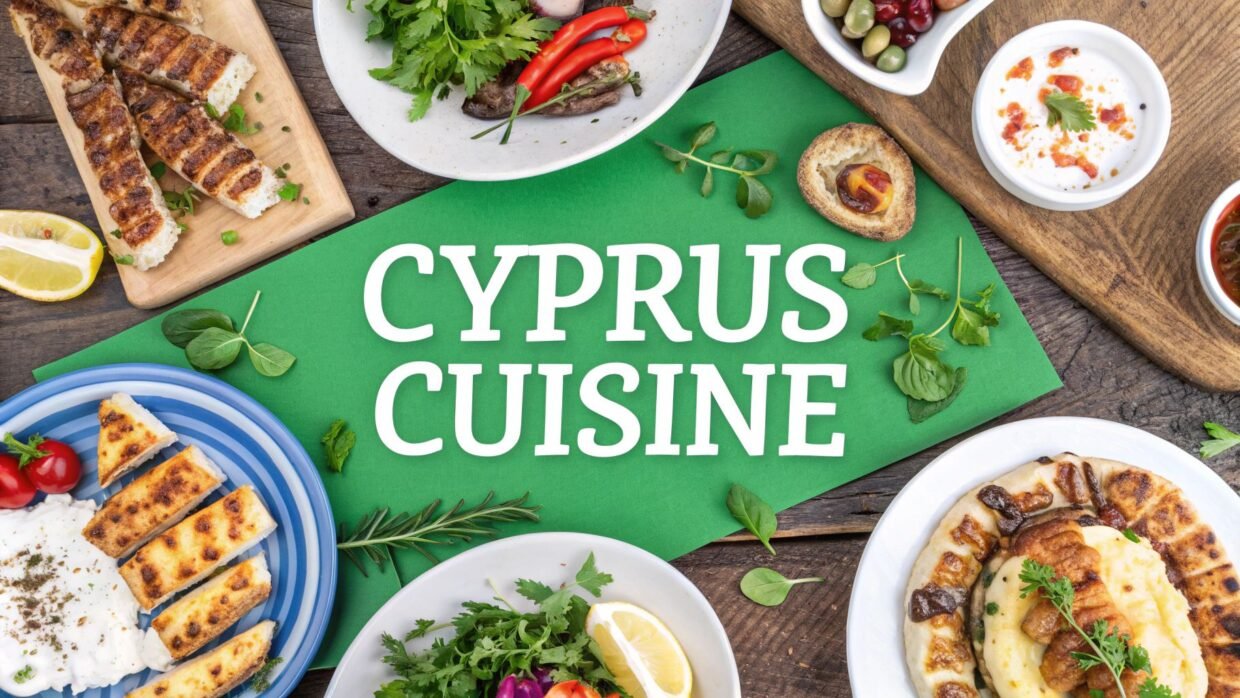Welcome to the flavourful heart of the Mediterranean. When you think of Cyprus, images of sun-drenched beaches and ancient ruins likely come to mind. But to truly know this island is to taste it. The story of Cyprus is told through its cuisine, a rich tapestry woven from Greek, Turkish, and Middle Eastern influences, yet entirely its own.
This guide is your passport to the most authentic and typical Cyprus food, moving beyond the tourist trails to the dishes that families have shared for generations. We will explore the island's most iconic flavours, from the unmistakable sizzle of grilled halloumi to the slow-cooked tenderness of kleftiko. This is more than just a list; it is a curated journey through the essential tastes that define Cypriot culture.
You will learn what makes each dish special, how it is traditionally prepared, and the best ways to enjoy it like a local. We will cover seven quintessential dishes, including souvlaki, moussaka, and meze, providing a comprehensive overview for any visitor eager to experience the island's culinary soul. Get ready to embark on a journey that will delight your senses and connect you to the true essence of Cyprus.
1. Souvlaki
Souvlaki is arguably the king of Cypriot street food and a cornerstone of the island's culinary identity. While many are familiar with the Greek version, Cypriot souvlaki stands out for its generous portions and distinct preparation. It consists of small, tender chunks of meat, typically pork or chicken, marinated in a simple yet flavourful mix of olive oil, lemon juice, salt, and oregano. The meat is then threaded onto skewers and grilled over hot charcoal, which imparts a signature smoky aroma and taste. This method makes it a quintessential example of typical Cyprus food, celebrated for its simplicity and deliciousness.

Unlike its Greek counterpart, which often comes with a variety of sauces and fries inside the wrap, Cypriot souvlaki is served in a large, pocketed pita bread. This special Cypriot pita is thinner and wider, allowing it to be filled with the grilled meat and a fresh, crunchy salad of cucumber, tomatoes, white cabbage, onions, and parsley. It is typically finished with a drizzle of tahini sauce or tzatziki, creating a balanced and substantial meal that can be enjoyed on the go or in a traditional taverna.
Where to Try Authentic Souvlaki
Finding great souvlaki is easy across Cyprus, from bustling city centres to quiet village squares.
- Psaromoura Restaurant (Limassol): Known for its authentic charcoal-grilled souvlaki, offering a traditional taste that locals love.
- Old Town Nicosia: Explore the street food vendors in the capital's historic centre for classic, no-frills souvlaki served hot off the grill.
- Beachside Tavernas (Ayia Napa): Many coastal eateries specialise in freshly grilled souvlaki, perfect for a satisfying meal after a day by the sea.
Tips for Perfect Souvlaki
To get the most authentic flavour, whether at home or ordering out, keep these tips in mind. For a deeper dive into the dish and its variations, you can find more information about souvlaki and other traditional Cyprus foods here.
- Marination is Key: Allow the meat to marinate for at least 2-4 hours, or ideally overnight, to fully absorb the flavours.
- Don't Overcrowd the Grill: Ensure there is space between skewers for even cooking and a good char.
- Let it Rest: Let the meat rest for five minutes after grilling to keep it juicy and tender.
2. Halloumi
Halloumi is undoubtedly Cyprus's most famous culinary export and a source of immense national pride. This unique, semi-hard, unripened cheese is traditionally made from a blend of goat's and sheep's milk, although cow's milk is sometimes included. Its most remarkable characteristic is its high melting point, which allows it to be grilled or fried to a perfect golden-brown crisp without losing its shape. This texture, combined with its distinctively salty flavour, makes it a versatile and beloved component of typical Cyprus food.

As a product with Protected Designation of Origin (PDO) status, authentic halloumi can only be produced in Cyprus, ensuring its quality and heritage are preserved. It is often served simply grilled or pan-fried as part of a meze platter, but it also features in salads, sandwiches, and even pasta dishes. One of the most classic and refreshing ways to enjoy it during the warm summer months is served cold, in slices, alongside fresh watermelon – a sweet and savoury combination that perfectly captures the island’s essence.
Where to Try Authentic Halloumi
You can find halloumi on nearly every menu in Cyprus, from high-end restaurants to humble village tavernas.
- Village Tavernas (Troodos Mountains): Many small, family-run eateries in the mountains make their own traditional halloumi, offering an authentic, rustic flavour.
- Pittas Dairy Products: As one of the island's largest producers, their halloumi is widely available in supermarkets and is a great example of high-quality, commercially produced cheese.
- Local Markets: Visit a local market (laiki) in any major town to buy fresh, locally made halloumi directly from producers.
Tips for Perfect Halloumi
Whether you're cooking it at home or enjoying it in a restaurant, a few tips can enhance the experience. To discover more about its history and uses, you can find a comprehensive guide to halloumi and other traditional dishes here.
- Grill it Right: Grill or fry slices over a medium-high heat for 2-3 minutes per side until golden and slightly soft.
- Reduce Saltiness: If you find it too salty, soak the block of halloumi in cold water for 30 minutes before cooking.
- Serve Immediately: Halloumi is best enjoyed hot, straight from the pan or grill, as its signature squeaky texture is most pronounced when warm.
3. Kleftiko
Kleftiko is a legendary Cypriot dish that embodies the island's rustic culinary heritage through its slow-cooking method and deep, aromatic flavours. The name translates to 'stolen meat,' alluding to a time when bandits would steal livestock and cook it in sealed, underground earth ovens to trap the smoke and avoid detection. Today, this traditional dish features lamb, typically a leg or shoulder, marinated in olive oil, lemon, garlic, and herbs like oregano and bay leaves. It is a prime example of typical Cyprus food, celebrated for its fall-off-the-bone tenderness and rich, concentrated taste.

The magic of Kleftiko lies in its preparation. The meat, often accompanied by potatoes that absorb the delicious juices, is tightly wrapped in parchment paper or foil, or placed in a covered clay pot. It is then slow-cooked for several hours at a low temperature until it becomes incredibly succulent and flavourful. This sealed cooking method steams the meat in its own juices, ensuring every bite is moist and infused with the marinade. It’s traditionally served simply with a side of fresh salad and a wedge of lemon, allowing the quality of the lamb to shine.
Where to Try Authentic Kleftiko
While a staple in many tavernas, finding a truly authentic Kleftiko cooked in a traditional clay oven is a special treat.
- Militzis Restaurant (Larnaca): Renowned across the island, Militzis is famous for its Kleftiko, which is slow-cooked to perfection in large, traditional outdoor ovens.
- Village Tavernas (Troodos Mountains): Many family-run eateries in the mountain villages offer an authentic Kleftiko experience, often as part of a Sunday lunch special.
- Easter Celebrations: Kleftiko is a popular dish during major holidays like Easter, where families often prepare it at home using time-honoured recipes.
Tips for Perfect Kleftiko
To recreate this classic dish, patience and proper technique are essential for achieving that signature tenderness.
- Score the Meat: Make small incisions in the lamb and insert slivers of garlic for maximum flavour penetration.
- Low and Slow: Cook at a low temperature (around 160°C) for at least 4-5 hours for optimal tenderness.
- Keep it Sealed: Do not open the parcel during cooking, as this releases the steam that keeps the meat moist.
- Rest Before Serving: Allow the Kleftiko to rest, still wrapped, for 10-15 minutes after removing it from the oven to let the juices redistribute.
4. Moussaka
Moussaka is a beloved, hearty casserole that holds a special place in Cypriot kitchens, often served at family gatherings and celebrations. While many are familiar with the Greek version, Cypriot moussaka often has its own unique twist. The dish is built on layers of savoury ground meat, typically lamb or beef, cooked in a rich tomato and cinnamon sauce, and sliced vegetables. This is then topped with a thick, creamy béchamel sauce and baked until golden and bubbling, making it a truly comforting example of typical Cyprus food.
The key difference in the Cypriot preparation is often the choice of vegetables. While aubergine is common, it is just as traditional to find thinly sliced potatoes or courgettes forming the base layers. This variation gives the dish a distinct texture and flavour profile. Baked in a large earthenware dish known as a tapsi, this rich and satisfying meal is more than just food; it’s a centrepiece of Cypriot hospitality, perfect for a long, leisurely lunch.
Where to Try Authentic Moussaka
From family-run tavernas to festival food stalls, authentic moussaka is a staple across the island.
- To Anamma (Nicosia): This renowned restaurant in the capital is celebrated for its traditional, home-style moussaka that tastes just like a Cypriot grandmother would make it.
- Village Festivals: Keep an eye out for local village festivals, where moussaka is often prepared in huge quantities and served communally, offering a truly authentic taste.
- Voreas Tavern (Oroklini): A classic village taverna that serves a fantastic moussaka, showcasing the best of traditional Cypriot cooking in a rustic setting.
Tips for Perfect Moussaka
Crafting the perfect moussaka requires patience and attention to detail. These tips will help you master this classic dish.
- Remove Excess Moisture: Salt and drain the sliced courgettes or aubergines for about 30 minutes to draw out water. This prevents the moussaka from becoming soggy.
- Pre-cook the Vegetables: Lightly fry or grill the vegetable slices before layering them in the dish. This enhances their flavour and ensures they are tender.
- Let it Rest: Allow the moussaka to cool for at least 15-20 minutes after baking. This helps it set, allowing for clean, beautiful slices when serving.
5. Meze
More than just a meal, Meze is a cornerstone of Cypriot social and culinary culture. It is not a single dish but a grand procession of small plates, often numbering between 20 to 30, that are served in waves over several hours. This dining experience embodies the island's spirit of hospitality and generosity, turning a simple meal into a festive event. A typical Meze is a journey through the best of typical Cyprus food, starting with cold dips, salads, and olives, moving on to grilled vegetables, seafood, and local cheeses like halloumi, before culminating in a variety of grilled meats.
The Meze is designed to be shared among family and friends, encouraging conversation and a leisurely pace. The experience varies from taverna to taverna, with some focusing on meat (a meat meze) and others on fish (a fish meze), though a mixed meze is also common. From tahini and taramosalata to loukaniko (spicy sausage), sheftalia, and lamb kleftiko, the array of flavours and textures is vast. It’s a perfect way for visitors to sample a comprehensive range of Cypriot specialities in one sitting.
Where to Experience an Authentic Meze
A true Meze is best enjoyed in a traditional taverna where the dishes are homemade and the atmosphere is welcoming.
- Cleopatra Restaurant (Paphos): Famous for its comprehensive 28-dish meze that offers a full gastronomic tour of the island’s cuisine.
- Omodos & Lefkara Villages: The traditional village tavernas in these mountainous regions provide an authentic setting and locally sourced ingredients for their Meze.
- Wedding Celebrations: If you're lucky enough to be invited to a Cypriot wedding or large family gathering, you'll experience Meze in its grandest and most celebratory form.
Tips for a Perfect Meze Experience
To fully appreciate this Cypriot tradition, it helps to know how to approach the feast. For more insights into the island's dining culture, you can discover more about Meze and Cyprus traditional cuisine here.
- Pace Yourself: The dishes keep coming, so eat small portions of each to ensure you have room for the main meat courses at the end.
- Try Everything: Be adventurous and sample each dish before settling on your favourites; you might discover something new you love.
- Share Generously: Meze is a communal experience. Sharing and discussing the dishes with your companions is part of the fun.
- Communicate Dietary Needs: Don't hesitate to ask your server about ingredients if you have any allergies or dietary restrictions.
6. Koupepia (Dolmades)
Koupepia, also widely known as Dolmades, are a beloved delicacy and a staple of Cypriot meze platters. These tender vine leaves are meticulously filled with a savoury mixture of minced meat (usually pork or beef), rice, fresh tomatoes, onions, and an aromatic blend of herbs. What makes the Cypriot version of this typical Cyprus food so distinctive is the generous use of fresh mint and dill, which infuses the filling with a uniquely fresh and fragrant flavour. The little parcels are then arranged snugly in a pot and slowly simmered in a flavourful tomato and lemon broth until perfectly tender.
Often prepared as a labour of love, koupepia are a common sight at family gatherings, celebrations, and village festivals, where community preparation is a cherished tradition. While the meat version is classic, vegetarian variations, known as "orphana" (meaning orphans), are also popular, especially during fasting periods. Served either warm or at room temperature, often with a side of thick, creamy yoghurt, koupepia can be enjoyed as a light appetiser to start a meal or as part of a larger main course selection, showcasing the versatility of Cypriot cuisine.
Where to Try Authentic Koupepia
From traditional tavernas to monastery kitchens, you can find exceptional koupepia all over the island.
- Voreas Taverna (Oroklini, Larnaca): This family-run establishment is renowned for its authentic, homemade meze, where the koupepia are a standout highlight.
- Monastery of Kykkos: The monastery and its surrounding eateries often serve excellent vegetarian versions, prepared with care and traditional mountain herbs.
- To Katoi Restaurant (Omodos): Nestled in a picturesque wine village, this restaurant offers a fantastic culinary experience with koupepia made from cherished family recipes.
Tips for Perfect Koupepia
Making koupepia at home is a rewarding experience. These tips will help you master the art of rolling and cooking these delicious parcels.
- Prepare the Leaves: If using fresh vine leaves, blanch them in boiling water for a minute to make them soft and pliable for rolling.
- Don't Overfill: Remember that the rice will expand during cooking. Use about a teaspoon of filling per leaf to avoid them bursting open.
- Roll Tightly: Roll each leaf snugly, but not too tightly, folding in the sides first to create a neat parcel that allows the rice to cook evenly.
- Weigh Them Down: Place a small, heatproof plate on top of the koupepia in the pot before simmering. This keeps them submerged and prevents them from unravelling.
7. Afelia
Afelia is a quintessential rustic dish that perfectly encapsulates the heart of Cypriot home cooking, deeply connected to the island's rich wine-making heritage. This traditional pork stew is celebrated for its robust and aromatic flavour profile, making it a standout example of typical Cyprus food. The dish consists of small cubes of pork marinated in a generous amount of local red wine, then slow-cooked with crushed whole coriander seeds and bay leaves. This simple yet potent combination creates a deeply savoury and fragrant meal.
The magic of Afelia lies in its slow-cooking process. As the pork simmers gently, the red wine reduces to create a thick, rich sauce that clings to the tender meat, while the coriander seeds soften and release their distinctive citrusy, earthy notes. Traditionally, Afelia is served alongside pourgouri (bulgur wheat pilaf) or potatoes, which are perfect for soaking up the delicious sauce. It’s a hearty, warming dish often enjoyed during the cooler months and is a staple in village tavernas and family kitchens across the island.
Where to Try Authentic Afelia
You can find this comforting stew in many traditional tavernas, especially those in the island's famous wine regions.
- Vavatsinia Restaurant (Vavatsinia Village): Located in a mountain village, this taverna is renowned for its authentic, slow-cooked Afelia that tastes just like a Cypriot grandmother would make it.
- Tavernas in the Omodos and Platres villages: These wine-producing areas are the perfect place to sample Afelia made with high-quality local red wine.
- Militzis Restaurant (Larnaca): A well-known establishment famous for its traditional clay-oven cooking, offering a beautifully prepared Afelia.
Tips for Perfect Afelia
To capture the true essence of this Cypriot classic, attention to detail is crucial. For more insights into this and other traditional dishes, you can explore a wider range of typical Cyprus food here.
- Use Whole Coriander Seeds: Crush whole seeds just before using them, rather than using pre-ground powder, to release the most potent and authentic flavour.
- Choose a Robust Red Wine: A dry, full-bodied local Cypriot red wine like Maratheftiko or Mavro will give the sauce the best depth and character.
- Brown the Meat First: Searing the pork cubes before adding the wine helps to lock in the juices and builds a deeper, more complex flavour base for the stew.
- Simmer Gently: Cook the Afelia on a low heat for a long time. This ensures the pork becomes fork-tender without drying out.
7 Typical Cyprus Foods Comparison
| Dish | Implementation Complexity 🔄 | Resource Requirements ⚡ | Expected Outcomes 📊 | Ideal Use Cases 💡 | Key Advantages ⭐ |
|---|---|---|---|---|---|
| Souvlaki | Medium: Requires hours of marination and charcoal grilling | Moderate: Meat, marinade ingredients, grill setup | Juicy, smoky grilled meat skewers, balanced meal | Outdoor cooking, social gatherings, quick post-marination prep | High protein, healthy grilling, popular universally |
| Halloumi | Low-Medium: Simple grilling/frying with minimal prep | Low: Cheese only, grill or frying pan | Grilled cheese with unique texture, creamy salty flavor | Light meals, appetizers, versatile snack or side | Unique non-melting cheese, high protein & calcium |
| Kleftiko | High: Slow oven cooking for 3-4 hours, sealed package | Moderate-High: Quality lamb cuts, cooking equipment | Tender, flavorful slow-cooked lamb, moist and aromatic | Special occasions, communal dinners, slow meal preparation | Exceptional tenderness, concentrated flavors |
| Moussaka | High: Multiple steps – layering, sauce-making, baking | Moderate-High: Various vegetables, meat, dairy | Rich, hearty layered casserole, comforting and filling | Family meals, large groups, make-ahead dishes | Complete balanced meal, economical for groups |
| Meze | Very High: Preparation of 20-30 small dishes, varied techniques | High: Wide range of ingredients, diverse dishes | Extensive variety tasting experience, social engagement | Celebrations, long social meals, diverse dietary needs | Variety of flavors, promotes sharing and hospitality |
| Koupepia | High: Labor-intensive rolling and slow simmering | Moderate: Vine leaves, meat/rice, herbs | Flavorful stuffed vine leaves, visually impressive | Family traditions, appetizers, entertaining guests | Healthy, customizable vegetarian option |
| Afelia | Medium: Marination and slow cooking in wine | Moderate: Pork, red wine, spices | Rich, aromatic pork dish with wine-reduced sauce | Seasonal meals, rustic home cooking, wine pairings | Complex flavors, economical cuts, traditional character |
Your Next Meal in Cyprus Awaits
The culinary journey through Cyprus is a vibrant exploration of history, culture, and pure, unadulterated flavour. From the smoky, chargrilled perfection of souvlaki skewers to the comforting, slow-cooked lamb of kleftiko, each dish tells a story of the island's rich heritage. You’ve seen how simple ingredients, like squeaky halloumi cheese, can become global sensations, and how complex layers in a moussaka reflect centuries of culinary influence.
Understanding typical Cyprus food is about recognising that a meal is rarely just a meal; it's an event. The concept of the meze perfectly encapsulates this spirit, transforming dining into a shared, social celebration of small, flavour-packed plates. Whether you're savouring the delicate, herb-infused rice in koupepia or the rich, wine-braised pork of afelia, you are participating in a tradition passed down through generations. These dishes are the heart of Cypriot hospitality, served with pride in bustling city tavernas and quiet mountain villages alike.
Turning Knowledge into Flavourful Experiences
Simply reading about these dishes is just the beginning. The real magic happens when you take the first bite. To truly connect with Cypriot cuisine, you must immerse yourself in the local dining culture. Don't be afraid to step off the beaten path and find a family-run taverna where the menu is in Greek and the recipes have been perfected over decades.
Here are some actionable next steps for your culinary adventure:
- Create a Culinary Checklist: Use this list as your starting point. Aim to try at least four or five of these iconic dishes during your visit. This transforms your meals from simple sustenance into a purposeful exploration of the island's gastronomic identity.
- Ask for the "Special of the Day": Many traditional eateries cook specific dishes like kleftiko or moussaka on certain days of the week. Asking what's special often leads you to the freshest and most authentic meal available.
- Engage with Locals: When you order, ask your waiter about the dish's history or how it's prepared. Cypriots are famously proud of their food, and a simple question can open the door to fascinating stories and even a recommendation for your next meal.
Embracing the island's food is about more than just satisfying your hunger; it’s about experiencing Cyprus with all your senses. It’s the sizzle of halloumi on the grill, the aroma of oregano and lemon, and the warmth of a shared meal with friends, old and new. This is how you create lasting travel memories, one delicious bite at a time. The true taste of Cyprus is waiting for you.
Ready to plan your unforgettable culinary tour of Cyprus? At SayCyprus, we specialise in crafting bespoke travel experiences, from uncovering hidden gem tavernas to organising local cooking classes. Visit SayCyprus to explore our guides and start planning the delicious adventure you deserve.










